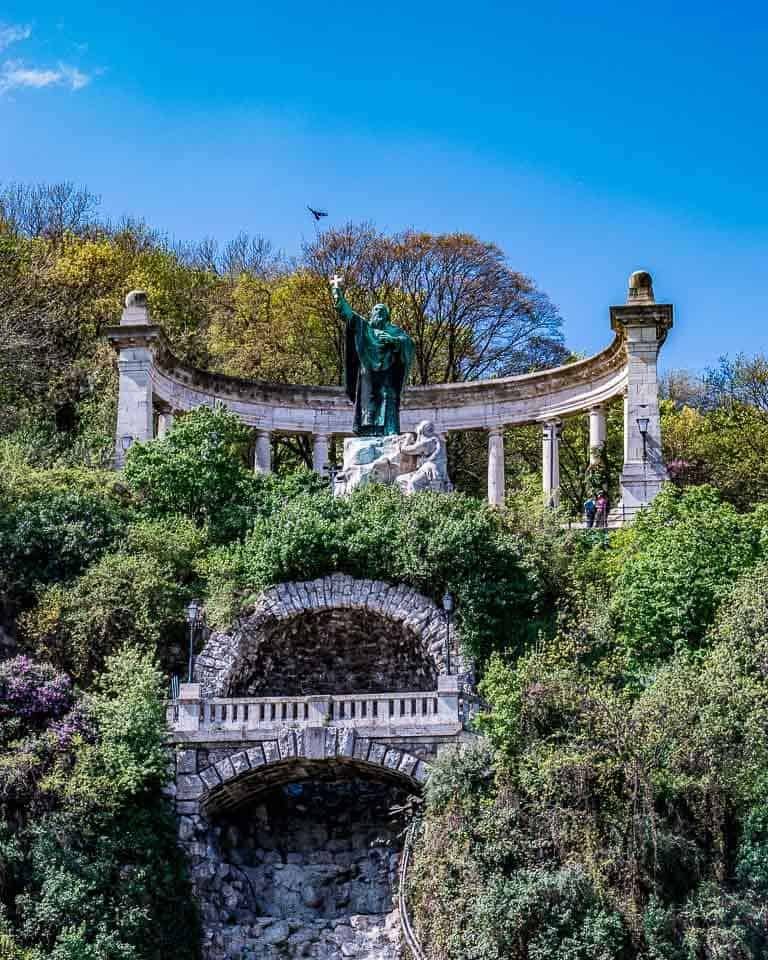I’ve created a bucket list to help you choose best of all Budapest attractions.
Simply download it, print it and have fun exploring the city with this list in your hands! 😊

Castle Hill rises above the Danube with its 60 m (197 ft) height, providing a good strategic position for its inhabitants since the Middle Ages.
In the 13th century, after the Tatar invasion King Béla IV decided to build a defensive castle. The 15th century under the reign of King Matthias was an important period in the evolution of Buda. Under the 145 years of Turkish rule came soon after King Matthias the area suffered from neglect and was destroyed by Christina armies during its reoccupation.
It play an important role again during the 18th and 19th centuries during the Habsburg era.
Unfortunately by the end of World War II it had been destroyed again. Since then the Royal Palace and the Old Town have been reconstructed.
Here is my post about the Castle District in details.
Royal Palace
Its current for dates from the rebuilding of the 19th century palace after its destruction in 1945. Remains of the 15th century Gothic palace were uncovered. Defensive walls and royal chambers revealed. The light stones in the Lion Courtyard show where the original walls were.
Today the Royal Palace gives home to 3 institutions:
Budapest History Museum
National Széchényi Library
Hungarian National Gallery
Old Town
It is the residential part of the Castle Hill that dates back to the 13th century. The area suffered a lot during its history, it was destroyed and rebuilt numerous times. Still, genuine relics can be found in its cobbled streets and squares.
Úri street

Aristocrats and merchants lived here. Houses have medieval foundations, Gothic details and peaceful courtyards.
Fisherman's Bastion

Fisherman’s Bastion was designed by Frigyes Schulek in 1895 and never had a defensive role. It seres as a lookout terrace.
The towers are an allusion to the tribal tents of the early Magyars.
Hospital in the Rock Nuclear Bunker Museum
There is a huge system of natural caves under Buda Castle that functioned as a shelter for thousands of people during World War II. There was also an emergency surgery here that operated from 1944-45. After the war the Communist government classified it as top secret and became a nuclear bunker by 1962.
Today it can be visited, I recommend to visit it. (There are wax figures in it and the cellars are quite narrow at some points. It might be frightening for kids, so check out the gallery on its website before visiting it with your children.)
Gellért Hill
The 140m (460 ft) height Gellért Hill rises steeply beside the Danube, prodding a beautiful view of the whole Budapest underneath it. This area played an important role in the lives of its citizens.
During the Middle Ages “witches” lived, danced and celebrated their sabbath here.
The first small stronghold built here to protect Buda was built by the Turks.
Later, Austrians used the Citadel against Hungarians.
At the end of the 19th century the hill began to change and became a hiking, picnic spot.
My post about the hill can be read here.
Statue of St. Gellért

Gellért Hill was named after Bishop Gellért, who was trying to covert those who lived here to Christianity and was threw down from the hill in a barrel to his death.
Today his statue stands facing Elisabeth Bridge.
Citadel
Today people come here to explore the walls and enjoy the view from here, but originally it was a place of terror.
Statue of Liberty

The 14 m (46 ft) height woman figure holds a palm leaf in her hands. Originally the statue wasn’t meant to honour the Russian troops who liberated Budapest in 1945, but was reassigned to this purpose. The arrival of the Russians was a liberation, but they arrived without any intention to leave, so it was also the beginning of the Soviet rule. After the Communism’s fall, the statue of a Russian soldier that also stood here had to leave (was moved to Statue Park).
At the base of the statue there are two states representing the battle with the evil.
Cave Church
This church is on the southern slope of Gellért Hill. It was established in 1926, intended for the Pauline order of monks that was founded in the 13th century.
Under the Communist rule, the Pauline order was forced to leave the church, and it was reopened only in 1989, after the fall of Communism.
Lookout terrace

The main lookout terrace of the Gellért Hill provides a beautiful panorama of the city.
Rudas Baths
It is a famous Turkish baths, dating back to the 16th century. The main part of the baths have an octagonal plunge pool and four small corner pools with different temperatures.
The spa pools are mixed on weekends, but Tuesdays are only for women while the rest of the week is only for men.
Gellért Baths

It was built at the beginning of the 20th century in modernist Secession style and it exploits the natural hot springs of the area.
If you are interested in the thermal baths and their services, check out my blog post!
Chain Bridge

The bridge was built between 1839-49 as one of the initiations of Count István Széchenyi. It was designed by William Tierney Clark and built by Adam Clark (who were not related). The square at the foot of the bridge on the Buda side it called Clark Adam Square.
The bridge is 380 m (1250 ft) long and it is supported by two towers – it was a huge feat of engineering at that time.
On both sides of the bridge it is guarded by two lions sculptures.
Széchenyi Bath
This is the largest spa complex in Europe. Its hot springs that are coming from 970 m (3180 ft) deep. The water reaches the surface at a temperature of 74°C (165°F) and is rich in minerals. Bathing is recommended for treating rheumatism and disorders of the nervous system, joints and muscles.
The building of the spa was constructed in 1909-13 in a Neo-Baroque style.
Jewish District

The Great Synagogue in Dohány street is the largest in Europe and the second largest in the world. It was built in a Byzantine-Moorish style between 1854-59.
There is a large rose window on its facade, between the two towers topped with onion domes.
The area of the Jewish district is full of narrow streets, alleys and courtyard. With its several ruin bars, restaurants and hostels, today it is a very popular location among young tourists and locals, especially during the late afternoons and weekends.
Matthias Church

The church you see today is mainly a Neo-Gothic reconstruction dating from 1874-96, but it has parts from the 14th century.
If you are not claustrophobic I highly recommend taking a tour up to its lookout tower. Tours depart every hour.
I wrote a complete blog post about Matthias Church and its secrets.
Taste Hungarian dishes
Hungarian flavors originate from the fusion of Magyar, Turkish, Austrian, Balkan and even French influences. Not surprising that it became one of the most interesting and flavorful cuisine in central Europe.
I highly recommend trying lángos, csirkepaprikás and gulyásleves and I wrote a post about the amazing foods of Budapest, too. 😉
Architecture
Budapest boasts historic buildings in a broad range of architectural styles. The majority represent Neo-Classicism, Historicism and Secession of the 19th and early 20th centuries when a dynamic development of Budapest took place.
Secession is considered to be the best architectural style in Budapest. The majority of secessionist buildings are found in central Pest and around Városliget (City Park).
Visitors are often impressed by these 19th-20th century buildings.
Some examples:
- Gellért Hotel and Baths Complex
- Gresham Palace (have a look at its ironwork gate)
- New York Palace
- entrance of the Budapest Zoo
- Philanthia Florist shop on Váci street (interior of the shop is secessionist, the building itself is Neo-Classical)
House of Parliament

The Parliament is the largest building in Hungary, the symbol of Budapest. This Neo-Gothic masterpiece built between 1885-1902.
You can see its interior during a tour that takes 45 minutes.
Danube Promenade

The river bank on the Pest side between Elizabeth Bridge and the Chain Bridge is called Danube Promenade.
It was home to several famous hotels and their cafés in the 19th century and with their spectacular view of the Danube and the Buda Castle, they were very popular.
Even today, the Promenade is one of the main attractions of Budapest.
St. Stephen’s Basilica

The greatest Catholic Church in Budapest was dedicated to St. Stephen, the first Hungarian Christian king.
Hungary’s most unusual relic, the mummified forearm of King Stephen is kept here in the Chapel of the Holy Right Hand.
Its dome is 96 m (315 ft) height and it is visible from all over Budapest. There is a lookout terrace underneath it with gorgeous views over the entire city.
Details about the Basilica can be read here.
Heroes’ Square

Heroes’ Square was built for the Millennium Celebrations in 1896.
The colonnades of Millennium Monument features statues of Hungarian leaders and politicians,
while the central column is topped with the figure of Archangel Gabriel.
As an adjacent to the square, Vajdahunyad Castle was built in Városliget (City Park).
Vajdahunyad Castle is composed of elements of the finest architectural works found throughout Hungary. It was originally built from wood and paper but people loved it so much that it was soon rebuilt from stone, becoming true castle.
I hope that this list of the main attractions of Budapest and the short descriptions inspire you to visit us. Of course there are many other things to see and experience in Budapest, but if you manage to visit the ones listed in this post, you do not miss the best Budapest can offer.
I wish you a pleasant stay and make sure to download this bucket list in a one-page format from here.
If you also need itineraries, no worries! Check these out!
Pin for later:

If you liked this post, please share it with your friends, thank you! 😊
You might be interested in these blog posts, too:



Great post! I would add some ruin bars and you’ve pretty much covered the most relevant and unique places!
Iris, you are right! I will probably add those, thanks for the tip! 😉
How is nightlife there? heh. I am thinking of going to Budapest in summer and summer is too hot for me to walk out during the day.
Good question, Alexander! 🙂 I am planning to write a post about the nightlife in Budapest but until then: it’s lively! Budapest is famous for its ruin bars, for example. The Jewish district is full of these quirky bars and pubs. If you don’t enjoy hot weather, I would recommend skipping the Hungarian summer altogether. Come during spring or autumn, the weather is perfect that times.